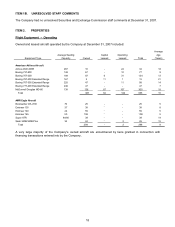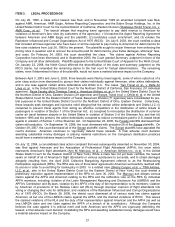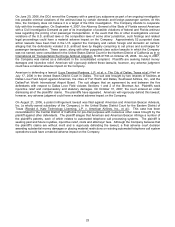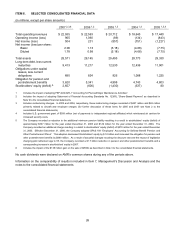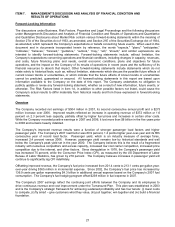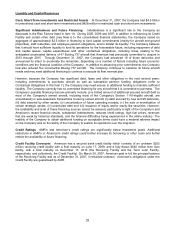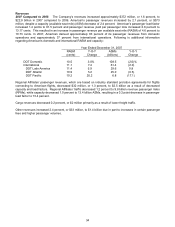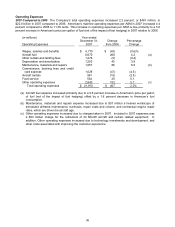American Airlines 2007 Annual Report Download - page 31
Download and view the complete annual report
Please find page 31 of the 2007 American Airlines annual report below. You can navigate through the pages in the report by either clicking on the pages listed below, or by using the keyword search tool below to find specific information within the annual report.28
Under the Turnaround Plan, the Company has implemented hundreds of cost savings initiatives estimated to save
approximately $3.8 billion in annual expense. In combination with the Company’s 2003 restructuring of labor and
other contracts, these initiatives have more than offset the Company’s non-fuel inflationary and other cost
pressures during this period. Although the Company’s cost per available seat mile increased from 11.54 cents in
2002 to 11.98 cents in 2007, the fuel component of unit cost increased from 1.43 cents to 3.63 cents over the
same period. All other components of unit cost decreased from 10.11 cents in 2002, to 8.35 cents in 2007, or
17.4 percent. Employee productivity (measured in available seat miles per full time equivalent head) and aircraft
productivity (measured in miles flown per day) consistently increased during this period.
The Company has also implemented numerous efforts to find additional revenue sources and increase existing
ones. In addition to improving core passenger and cargo revenues, these efforts have contributed to an increase
in Other revenue from $966 million in 2002 to $1.4 billion in 2007. Examples of new revenue sources over this
period include onboard food sales, single day passes for AAdmirals Club admission, reservations ticketing fees,
First Class upgrades on day of departure, and numerous other initiatives.
As a key part of these efforts, the Company has sought to engage its labor unions and its employees in jointly
working together. The Company believes heightened employee engagement has directly contributed to its
progress under the Turnaround Plan.
Lastly, under the Turnaround Plan, the Company has worked to reduce debt, increase the funded status of
employee pension plans and improve financial flexibility for the future. Historically, airline industry earnings are
highly cyclical with frequent and extended periods of significant losses, and an airline’s liquidity and borrowing
capacity can be critical to sustaining operations. The Company has reduced its balance sheet debt (Short-Term
Debt plus Long-Term Debt) from $13.2 billion at the end of 2002 to $11.1 billion at year end 2007. Over the same
period, total Cash and Short-term investments (including restricted cash and short-term investments) have
increased by $2.3 billion to $5.0 billion and the ratio of the fair value of plan assets to the accumulated benefit
obligations of the employee pension programs has increased from 75 percent to 96 percent.
On November 28, 2007, the Company announced that it plans to divest AMR Eagle (American Eagle Airlines,
Inc., and Executive Airlines, Inc.), its wholly-owned regional carrier. AMR believes that a divestiture of AMR Eagle
is in the long-term best interests of the Company and its shareholders. The Company continues to evaluate the
form of the divestiture, which may include a spin-off to AMR shareholders, a sale to a third party, or some other
form of separation from AMR. The Company expects to complete the divestiture in 2008; however, the completion
of any transaction and its timing will depend on a number of factors, including general economic, industry and
financial market conditions, as well as the ultimate form of the divestiture. The impact on AMR of divesting AMR
Eagle is not currently quantifiable due to these uncertainties and the potential restructuring of assets, liabilities
and the capacity purchase agreement between American and AMR Eagle. In addition, AMR Eagle’s historical
financial information is not indicative of the AMR Eagle’s future results of operations, financial position and cash
flows if AMR Eagle had been a stand-alone entity.
The Company’s ability to become consistently profitable and its ability to continue to fund it obligations on an
ongoing basis will depend on a number of factors, many of which are largely beyond the Company’s control.
Certain risk factors that affect the Company’s business and financial results are discussed in the Risk Factors
listed in Item 1A. In addition, four of the Company’s largest domestic competitors have filed for bankruptcy in the
last several years and have used this process to significantly reduce contractual labor and other costs. In order
to remain competitive and to improve its financial condition, the Company must continue to take steps to generate
additional revenues and to reduce its costs. Although the Company has a number of initiatives underway to
address its cost and revenue challenges, the ultimate success of these initiatives is not known at this time and
cannot be assured.


